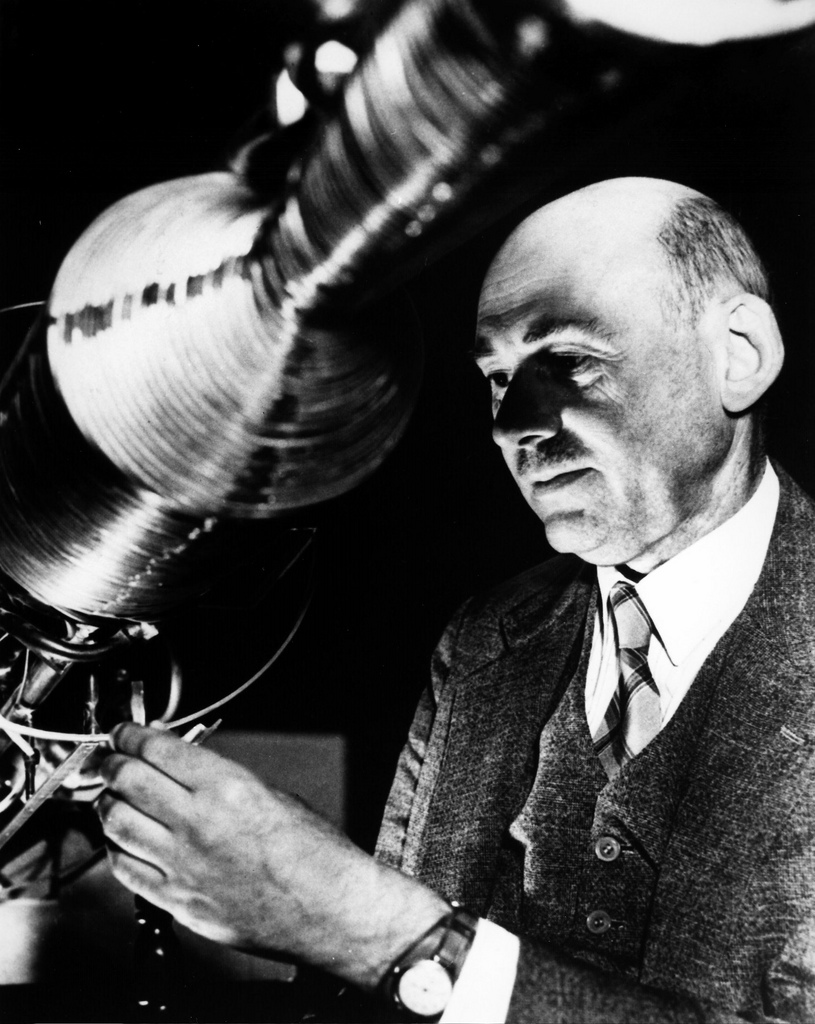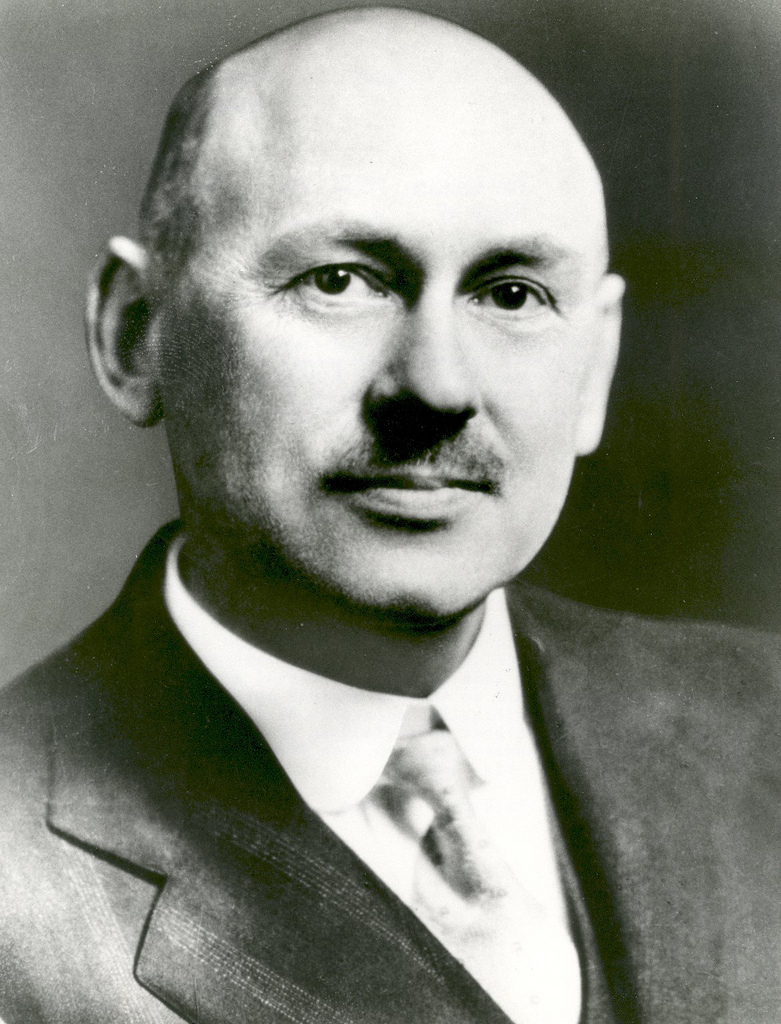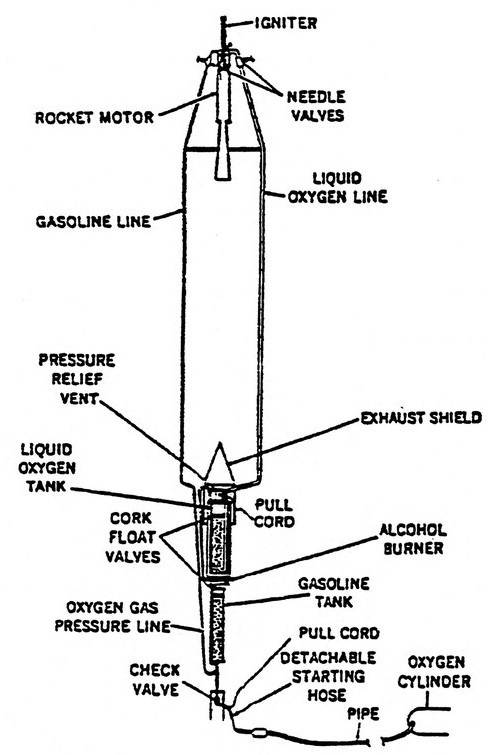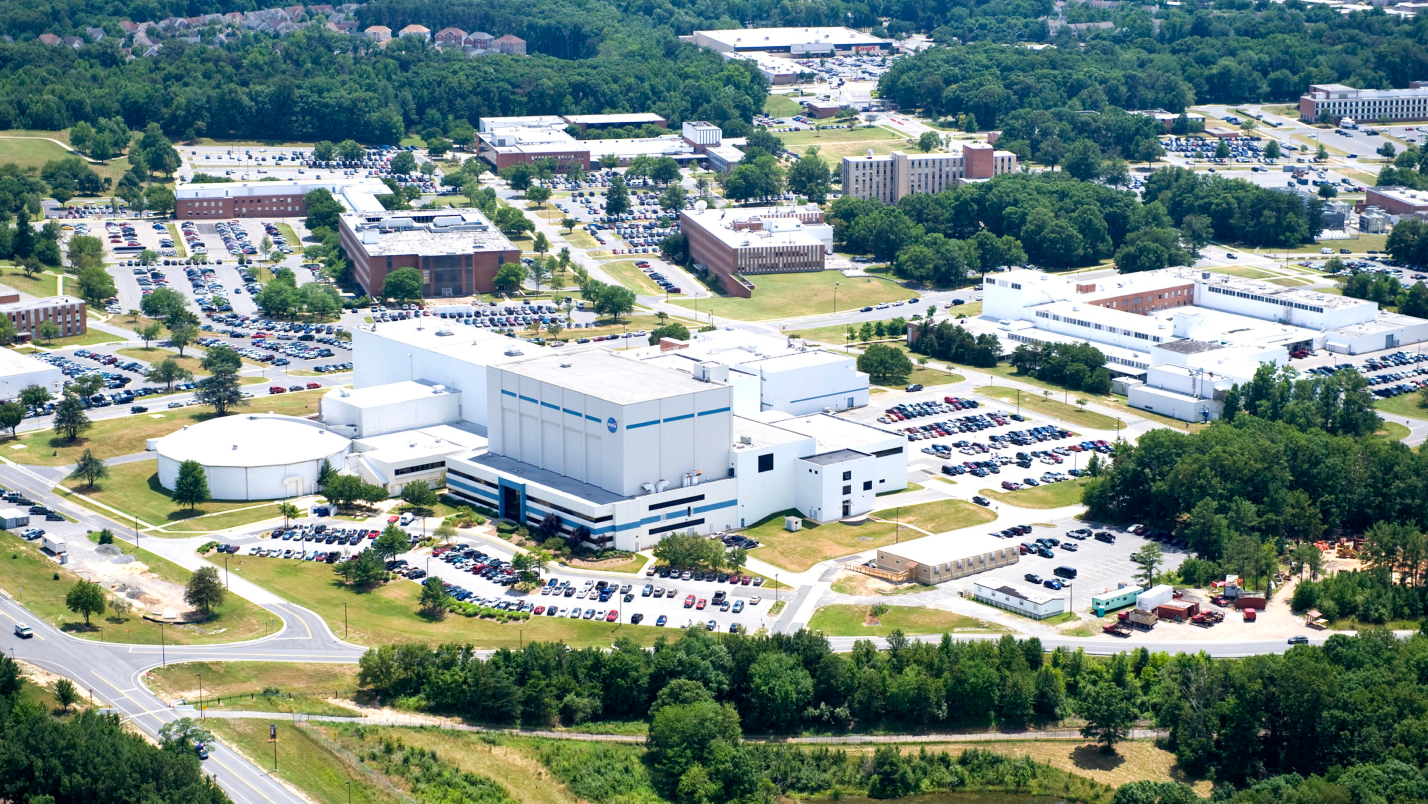Educator Onboarding
LEO Art Challenge Workshop
Satellite Tracking, Orbits, and Modeling
Workshop: Satellite Tracking, Orbits, and Modeling
Workshop: Trek-a-Sat
Workshop: Yerkes
Workshop: Electrostatics in Space - Carthage- Yerkes
Workshop: Life in Space! BTCI
Workshop: More Than a Rainbow - Yerkes
Workshop: Small Steps Teachimg Space Brings Giant Steps in Classrooms-SEEC
Workshop: 2017-01-28 Yerkes
Tools You Might Use
Educational Learning
Standards
Documentation
Goddard Contributions
Topic outline
-
Title: Robert H. Goddard’s Contributions
Disclaimer: This is not a complete biography; however, our hope is to bring awareness of Goddard’s contributions through this short lesson.
Contributors: Bhumika Kalia (University of Chicago)
Frances Dellutri (NSS, Director of Education)
Loretta Hall, NSS Space Ambassador
Robert Hutchings Goddard, otherwise known as the "Father of Modern Rocketry," was born on October 5th, 1882 and had been making an impact on rocketry until his death on August 10th, 1945. His insight as both a physicist and an inventor made him find groundbreaking ideas, but he endured an immense amount of skepticism from the press, as well as his peers. Despite his intelligence, Goddard received minimal support from his peers during his lifetime, yet he was still able to persevere with his inventions. Here is an interesting NASA 2-minute introduction about Goddard.
Goals of the Lesson:
Introduce the history of rocketry by informing students on Robert H. Goddard, the “father of rocketry.”
For students to develop problem-solving skills after learning about Goddard’s early life and career as an engineer and a physicist.
For students to understand the importance of design skills that are essential in everyday life.
To challenge students to explore their interests and learn more about their special hobbies through their creativity.
Grade Levels: Middle School & High School Students
Education Standards:
CCSS: U.S. Common Core State Standards:
For Grades 6- 8 (Ages 11-14):
CCSS.ELA-Literacy.RST.6-8.2
Determine the central ideas or conclusions of a text; provide an accurate summary of the text distinct from prior knowledge or opinions.CCSS.ELA-Literacy.RI.8.2
Determine a central idea of a text and analyze its development over the course of the text, including its relationship to supporting ideas; provide an objective summary of the text.Here are the links to locate those standards, and there are others that may apply, too:
https://www.thecorestandards.org/ELA-Literacy/RST/6-8/
https://www.thecorestandards.org/ELA-Literacy/RI/8/
For high school (Grades 9 - 12, Ages 14 - 19):
CCSS.ELA-Literacy.RI.9-10.2
Determine a central idea of a text and analyze its development over the course of the text, including how it emerges and is shaped and refined by specific details; provide an objective summary of the text.CCSS.ELA-Literacy.RST.9-10.1
Cite specific textual evidence to support analysis of science and technical texts, attending to the precise details of explanations or descriptions.Links:
https://www.thecorestandards.org/ELA-Literacy/RST/9-10/
https://www.thecorestandards.org/ELA-Literacy/RST/11-12/
https://www.thecorestandards.org/ELA-Literacy/RI/9-10/
https://www.thecorestandards.org/ELA-Literacy/RI/11-12/
Tags: Rocketry, stability, gyroscope, Goddard, war of the worlds, solar wind, ion propulsion, rocket propulsion, engineering, design, inventions, research, Goddard100, propellants, engines.....
Dr. Robert Goddard, as shown below:

-
During his childhood, Goddard was often sick and physically weak, which meant he had to stay home quite frequently. At this time, he developed a strong love for reading, especially science fiction novels. In the 1800s, electric power was first introduced in the United States, allowing Goddard to learn more about his interest in physics through this invention. His parents were very supportive and encouraged him to explore his curiosity throughout his childhood.
Jules Verne, a French writer, inspired Robert Goddard with his science fiction books such as From the Earth to the Moon. These stories sparked Goddard’s passion for science, and motivated him to conduct personal experiments and research beginning in his youth. Another one of Goddard’s favorite authors was H.G. Wells. When Goddard was sixteen years old, he read The War of the Worlds and was thrilled at the idea of humans interacting with space through their exploration. As Loretta Hall noted, “The idea of humans interacting with creatures from another planet stayed with him, and the following year he became so intrigued with the notion that he decided to devote his life to helping make interplanetary travel possible. In later years, he read all of Wells’ novels, but each Christmas season, he reread War of the Worlds” (Loretta Hall, NSS Space Ambassador: https://authorhall.com/). His curiosity about life beyond Earth eventually led to the world’s first liquid-fueled rocket.
-
For more information regarding Goddard’s early life and his writing, please reference this piece by Loretta Hall, a NSS Space Ambassador.
-
-
On October 19,1899, Goddard was around 17 years old. He climbed a cherry tree to trim branches, and imagined that he sent a device to Mars where he began thinking about building his first rocket. This was so momentous to him that he later called it his “anniversary day” where he celebrated it each year as the moment he dedicated himself to building a device for spaceflight. This piqued his interest and his passion for science deepened. Goddard said, “I was a different boy when I descended the tree from when I ascended. Existence at last seemed very purposive.”
Goddard graduated from Worcester Polytechnic Institute (WPI), a private university in Worcester, Massachusetts, in 1908 with a degree in general science. During his time as an undergraduate student, Goddard submitted an article titled "Possibility of Investigating Interplanetary Space" to Scientific American, as well as another article to the WPI Journal. This was an important time for Goddard because he spent much of it completing personal research while studying technical literature and gyroscopes. His classmates seemed to recognize his efforts and dedication to science, so he was elected class vice president, president, and served as editor of the class yearbook.
After graduating from WPI, Goddard worked in the Physics Department for two years before pursuing advanced studies at Clark University, where he was a fellow from 1909 to 1911 and earned his Ph.D. He later worked as a research instructor in physics at Princeton University from 1912-1913. Due to his creativity and skills in STEM (Science, Technology, Engineering, and Mathematics), Goddard gained access to many facilities for his rocketry experiments. At this time, he continued his personal research in different laboratories, and in 1917, he received his first grant of $5,000 from the Smithsonian Institution to support his rocket research. Several documents and newspaper clippings of Goddard's time as a professor and researcher can be found HERE.
Goddard as a professor at Clark, from gettyimages:

-
According to Loretta Hall’s research, “As early as 1909, Goddard began considering more efficient propellants, including liquid fuels, ion propulsion, solar energy, and magnetic repulsion. The only one that seemed even possible at the time was liquid propellants, but the challenges of designing and building such an engine seemed so difficult that Goddard continued to try to find ways to make solid fuels more effective.” Although there were still many factors to consider in developing Goddard’s rocket, he was determined to create a sustainable invention.
In 1914, Goddard received two U.S. patents for critical innovations: One of which was a liquid-fueled rocket design, and the other was a multi-stage solid-fueled rocket system. Both of these designs are essential building blocks of rockets. You may find a list of most, if not all, of Goddard's patents HERE.
According to NASA, during this time, Goddard studied different types of gunpowder and how they could be utilized for rocket propulsion. Around 1916, he wrote a classic document in which he asked the Smithsonian Institution for funding in order to continue working on his research. Moving forward, this paper was published in January 1920, along with Goddard’s other research and Navy work. The document was titled “A Method of Reaching Extreme Altitudes” and it contained information he explained regarding his search for ways to send weather instruments higher into the sky than weather balloons could go. Using his strong grasp of mathematics and physics, Goddard was able to develop the math behind rocket propulsion and the theories that came with it.
Goddard's 1926 liquid-fueled rocket, from NASA.


-
An editorial from The New York Times, titled “A Severe Strain on Credulity” brought Goddard’s research to gain public attention, and also drew criticism. Although Goddard had been conducting experiments to prove his theories, he was often mocked by the press and several peers. According to a short book, Dr. Robert H. Goddard, by Doug West, the public did not understand Goddard’s vision for space exploration and rocketry, “The lack of support from the academia, the military, and the government, however, limited his pursuits.” On March 17, 2021, NASA published an article that consisted of a brief statement that The New York Times made, correcting themselves; Read HERE.
On March 16, 1926, Goddard launched the first liquid-fueled rocket. He had to overcome several obstacles in order to have reached this milestone, particularly regarding the combustion chamber and its oxidizer systems. In Loretta Hall’s piece on Goddard’s rocket development, she noted several challenges that he faced:Design and build a chamber that could withstand the heat and pressure of the combustion of the fuel and oxidizer.
Design a nozzle that would most effectively channel the exhaust gases.
Decide which fuel to use.
Develop a system to inject the fuel and oxidizer into the combustion chamber.
Solve the problems of rocket flight guidance and stability.
Develop an effective parachute deployment system.
Design the engine and propellant tanks to have minimum weight and maximum strength.
Develop launch equipment and procedures that ensured safety.
For more information on Goddard’s engineering, please reference Loretta Hall's piece attached. With the help of his assistant, Nils Riffolt, Goddard began developing his rocket in 1921. Although its progress was initially slow due to minimal funding, Goddard connected with a few mentors.
In 1929, the scientist Charles A. Lindbergh met Goddard while researching rockets and new types of fuel during his time as a professor. Both scientists shared the belief that a rocket would someday reach the moon. Goddard needed all the support he could get during this time period, especially after being criticized by several peers and news articles. Lindbergh supported his research and used his connections to secure funding from Daniel Guggenheim, a notable philanthropist (https://www.mnhs.org/lindbergh/learn/other-occupations/scientist).

-
Although Dr. Robert H. Goddard is often remembered as the “father of modern rocketry”, his success is tied in with the support of his wife, Esther Christine Kisk, otherwise known as Esther Goddard (born in Worcester, Massachusetts in 1902). The pair met when Esther was working as a secretary at Clark University back in 1919, and despite their age gap of twenty years, they fell deeply in love and married in 1924. Esther eventually became more than a spouse to Goddard, and instead his steady partner in both life and his career as a rocket engineer.
Her influence helped Goddard’s achievements become possible after they moved to Roswell, New Mexico with the support of the Guggenheim Foundation. Esther created a stable environment that allowed Goddard to concentrate on his experiments, while also introducing him to social life through clubs, book circles, and hosting notable guests like the Lindberghs. After Goddard passed away, she took care of his legacy by transcribing his handwritten notes from his journal and promoting his contributions to the scientific world. She was heavily underappreciated, even though she played an important role as Goddard’s biggest advocate and greatest love. Please learn more about Esther’s contributions on the Goddard Memorial Association website, as well as this interview from Vimeo: https://vimeo.com/1070685433/a099e25536?ts=0&share=copy&fbclid=IwY2xjawM2jStleHRuA2FlbQIxMAABHviFflkJbEiRP-08mu43hpLaFJep--yq81uRSQRRnsrqWoRpMWhEoiTVbP0f_aem_zqXC8VnO-sYoj_q4C-bTGw
 Image from NASA's Goddard Space Flight Center Facebook.
Image from NASA's Goddard Space Flight Center Facebook. -
After Goddard passed away, many scientists were inspired by his groundbreaking publications and his 200+ patents, and they continued to develop his work into developing technologies. An example includes Sputnik (1957) from the Soviet Union, which was the first artificial satellite that used multi-stage liquid-fuel rockets that reflected ideas Goddard had introduced years before. Around one year later, the United States was able to send its first satellite, Explorer 1, into orbit. Goddard’s influence has always been around since his time, carrying it forward into The Apollo Program by NASA, where the Saturn V rocket used specific designs and guidance systems to have the ability to carry astronauts to the Moon. More examples of Goddard’s influence include the Space Shuttle and SpaceX's Falcon 9 rockets, in which they rely on liquid-fuel propulsion and rocket engineers use gyroscopes for guidance. See more in the videos below:
-
Rocket engineering is beyond just building machines, but the key to learning more about life and aspects outside of Earth. To Goddard, he saw rockets as tools that overcame the limits of space travel, something that he was ridiculed for at the time because it seemed impossible. Rocket science offers experiments with fuel, stability, and design, which were things that became most notable in Goddard’s inventions. For more information regarding rocket engineering, please view the attached file, written by Loretta Hall. Also, visit the following SpacEdge lessons if rocket engineering piqued your interest:
Rocket Engineering - MS (Grades 5-8)
Rocket Math and Propulsion (Grades 5-8)
The Mathematics Behind Mathematics and Rocketry (HS and University)
Rocket Engineering - Goddard (HS and University)
Propulsion 3-5
If you have ever wondered what it was like to be a rocket engineer during Goddard’s day, take a peek at this website from Clark University HERE. You may need to squint, but the newspaper clippings below gives a fascinating glimpse into the importance of rocket science back then!
-
Although Robert Goddard’s rocket development was improving and becoming more powerful, he wanted to be able to control them more effectively. In other words, as Loretta Hall explains, “Rather than flying upward to new heights, his rockets sometimes turned and flew horizontally. He couldn’t control what they might hit.” He used a gyroscope to be able to stabilize the rocket’s flight in order to keep it on its intended path, making his experiments much safer to test out and develop. By gaining better control over direction and stability, Goddard moved closer to transforming rockets into the foundation of modern-day space exploration.
In this video, you'll see Goddard with a gyroscope that he was working with, as well as an out of control rocket launch! For more information regarding gyroscopes, please visit our “Gyroscopes in Rocketry” lesson here on SpacEdge. You may also visit the file attached from Loretta Hall's research on Goddard and gyroscopes!
-
Goddard was both a scientist and an artist. When he wasn’t writing in his journal or reading science fiction novels, he painted landscapes as a form of relaxation. He received a set of painting supplies as a gift when he was around sixteen years old, and began his painting journey by purchasing watercolors and a sketchbook. Goddard was an appreciative child who found comfort in his surroundings, and made the most of the time he spent alone at home. More information on Goddard’s artistic eye can be found in Loretta Hall’s commentary about his art attached.
You can also create art like Goddard–Join us in celebrating 100 years of Robert H. Goddard! The National Space Society (NSS) is collaborating with BLUECUBE Aerospace to honor the “father of modern rocketry” by inviting students of different educational backgrounds to participate in a series of contests. These contests inspire both creativity and innovation, two of Goddard’s most important traits as he developed his first rocket! Check out the contest HERE.
-
The Goddard Space Flight Center (GSFC) is well worth a personal tour! It is NASA’s premiere space flight complex, consisting of a large organization of scientists, engineers, and technologists “who build spacecraft, instruments, and new technology to study Earth, the Sun, our solar system, and the universe.” “Goddard” is located in Greenbelt, Maryland and was founded on May 1, 1959, home to over 10,000+ people.

It is important to note that the GSFC introduces collaboration with artists and astronomers, scientists, and engineers in order to transform theories, designs, and concepts into visually compelling and scientifically precise representations. Although Robert Goddard was not a professional artist in a traditional sense, his developments required creativity and imagination, two traits he familiarized himself with as a child. The relationship between art and science is displayed at the GSFC through the new helio-physics exhibit, “Exploring the Spaces Between.” Paul Phister, NSS Space Ambassador, Board Member of the International Space Elevator Consortium (ISEC), highlights how engaging art projects are in NASA:
“NASA has used art for a long time to tell the story of its awe-inspiring missions. Soon after its inception, the agency started a formal program commissioning artists to develop inspiring pieces like portraits and paintings that highlighted an unexpected side of the agency. The vision of the reimagined NASA Art Program is to inspire and engage the Artemis Generation with community murals and other art projects for the benefit of humanity.”
Learn more about The Goddard Space Flight Center through Phister’s research HERE.
Check out this tour of the Goddard Space Flight Center:
-
Activity Inspired by: https://www.learningtogive.org/resources/blue-sky-envisioning-activity
Materials:
Large sheets of paper (poster paper).
Markers and colored pencils.
Information from this lesson.
Blue sky envisioning worksheet
Goals:
Encourage students to think about the future of space travel (inspired by the creative mindset of Robert Goddard).
Promote design thinking and innovation based on real scientific principles.
Empathy, teamwork, and creativity as students imagine solutions for the future using science and art!
Steps:
1. Lead the class into a discussion- What problem will we face in space in 50-100 years?
- What kind of invention or rocket might solve that problem?
- How would this invention help people or the planet?
- What materials or energy sources might it use (solar, ion propulsion, unknown sources)?
- How would Goddard view this invention if he were alive today?
2. Divide the class into small groups:
Instructions: (This activity was modified from Blue Sky Envisioning worksheet).
The small groups complete the “Cloud Input Activity” for dreaming of the next great leap in space exploration.
Add to the “Cloud Image” (Prompt: “Robert Goddard was mocked for his rocketry plans, but his ideas changed the world. What if YOU had to dream of the next great leap in space exploration? What do you imagine?”)
a). Students will work in groups to create a concept/invention that might help in the next great leap in space exploration.
To do so, students will:
Draw a diagram of their ideas for the future.
Label parts (materials, energy sources, etc)
Write a short description (what it does and why it matters)Share & Reflect with the rest of the class (what did you learn from Robert Goddard that inspired this idea?)
Be wild and creative, just like Goddard!
3. Show the whole class the following video:
(15 minutes).-
Add to this “Cloud Image” (Prompt: “Robert Goddard was mocked for his rocketry plans, but his ideas changed the world. What if YOU had to dream of the next great leap in space exploration? What do you imagine?”).
Modified from Blue Sky Envisioning Worksheet
-
Celebrate Goddard with NSS by sending a postcard to space.
NSS Supports Blue Origin Club For The Future initiative!
Visit: SpacEdge Academy Postcards in Space Course

